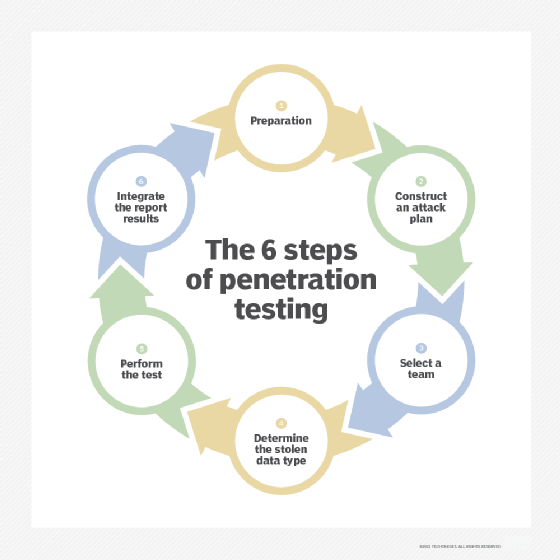What is penetration testing?
A penetration test, also called a pen test is a simulated cyberattack on a computer system, network or application to identify and highlight vulnerabilities in an organization's security posture.
Also known as ethical hacking, these tests are often carried out by ethical hackers. These in-house employees or third parties mimic the strategies and actions of an attacker to evaluate the hackability of an organization's computer systems, network or web applications. Organizations can also use pen testing to evaluate their adherence to compliance regulations.
Penetration testing is considered a proactive cybersecurity measure because it involves consistent, self-initiated improvements based on the reports the test generates. This differs from nonproactive approaches, which don't fix weaknesses as they arise. A nonproactive approach to cybersecurity, for example, would involve a company updating its firewall after a data breach occurs.
The goal of proactive measures, such as pen testing, is to minimize the number of retroactive upgrades and maximize an organization's security.
Why is pen testing important?
A test run of a cyberattack, a penetration test offers insights into the most vulnerable aspects of a system. It also serves as a mitigation technique, enabling organizations to close the identified loopholes before threat actors get to them.
The following are four reasons why organizations should conduct pen testing:
- Risk assessment. The rate of distributed denial of service (DoS), phishing and ransomware attacks is dramatically increasing, putting most companies at risk. Considering how reliant businesses are on technology, the consequences of a successful cyberattack have never been greater. A ransomware attack, for instance, could block a company from accessing the data, devices, networks and servers it relies on to conduct business. Such an attack could result in millions of dollars of lost revenue. Pen testing uses the hacker perspective to identify and mitigate cybersecurity risks before they're exploited. This helps IT leaders perform informed security upgrades that minimize the possibility of successful attacks.
- Security awareness. As technology continues to evolve, so do the methods cybercriminals use. For companies to successfully protect themselves and their assets from these attacks, they need to be able to update their security measures at the same rate. The caveat, however, is that it's often difficult to know which methods cybercriminals are using and how they might be used in an attack. But by using skilled ethical hackers, organizations can quickly and effectively identify, update and replace the parts of their systems that are particularly susceptible to modern hacking techniques.
- Reputation. A data breach can put a company's reputation at stake, especially if it goes public. Customers can lose confidence in the business and stop buying its products, while investors might be hesitant to invest in a business that doesn't take its cyberdefense seriously. Penetration testing protects the reputation of a business by offering proactive mitigation approaches.
- Compliance. Industries such as healthcare, banking and service providers take compliance and regulation seriously and include pen testing as part of their compliance efforts. Common regulations such as System and Organization Controls 2, the Health Insurance Portability and Accountability Act and the Payment Card Industry Data Security Standard require pen tests to be compliant. Therefore, by performing regularly scheduled pen testing, organizations can stay on top of their compliance needs.
Benefits of penetration testing
Penetration testing offers a wide range of benefits for organizations looking to improve their security posture and resilience. Here are some common benefits of conducting penetration testing:
- Identification and prioritization of vulnerabilities. Penetration tests provide a deeper analysis than automated scans, revealing complex and exploitable weaknesses in systems, networks and applications. They also help classify and prioritize vulnerabilities according to their potential effects and ease of exploitation, enabling organizations to concentrate their remediation efforts on the most significant issues.
- Real-world security assessment. By simulating actual attack scenarios, pen testing offers a realistic evaluation of an organization's security posture. This helps identify weaknesses in defense mechanisms and provides a better understanding of how an attacker might succeed when trying to infiltrate a system.
- Improved security controls and processes. The findings of a penetration test offer organizations the information needed to fine-tune their security defenses, such as firewalls, intrusion detection systems and access management. Additionally, it helps facilitate improvements to the security guidelines, operational processes and overall security architecture of the organization.
- Business continuity and reduced downtime. Pen testing can uncover weaknesses that could lead to system failures or disruptions. Addressing these vulnerabilities helps ensure business continuity and minimizes potential downtime caused by security incidents.
- Cost savings. Proactively addressing vulnerabilities through penetration testing is more cost-effective than dealing with the aftermath of a cyberattack. Penetration testing helps organizations identify and close security gaps before they're exploited, thereby preventing the financial losses associated with data breaches and system downtime.
Who performs penetration tests?
Pen testing is typically performed by pen testers known as ethical hackers. These ethical hackers are IT experts who use hacking methods to help companies identify possible entry points into their infrastructure. By using different methodologies, tools and approaches, organizations can perform simulated cyberattacks to test the strengths and weaknesses of their existing security systems. Penetration, in this case, refers to the degree to which a hypothetical threat actor, or hacker, can penetrate an organization's cybersecurity measures and protocols.
Most pen testers are experienced developers or security professionals with advanced credentials and pen testing certifications. It's always best to hire penetration testers who have little to no experience with the system they're trying to infiltrate. For example, a developer performing pen testing on their own source code might miss a few blind spots that a tester from outside can catch.
Team methodology in penetration testing
In penetration testing, the team methodology refers to the structured approach and collaboration among various specialized groups or teams to simulate real-world cyberattacks or exercises effectively. Here's a breakdown of common teaming approaches and types of ethical hackers:
- Red team. The red team is the core penetration testing team that simulates real-world attackers. Their goal is to identify and exploit vulnerabilities to gain unauthorized access, mimicking the tactics, techniques and procedures (TTPs) of actual threat actors. The red team operates offensively.
- Blue team. The blue team is the internal security team of the organization being tested. Their role is to detect, prevent and respond to the red team's activities, just as they would with a real attack.
- Purple team. This team facilitates collaboration between red and blue teams, ensuring that insights from simulated attacks are effectively communicated and used to enhance defensive strategies.
- Green team. The green team is responsible for developing and maintaining secure systems and applications. They integrate secure coding practices and conduct regular security reviews to identify and prevent vulnerabilities.
- Yellow team. This team's main responsibility is to focus on social engineering tactics, testing the organization's susceptibility to phishing and other manipulation techniques.
- White team. The white team oversees the entire penetration testing process, ensuring that ethical guidelines are followed, and that testing aligns with legal and organizational policies.
What are the types of penetration testing?
There are various types of pen testing strategies, each offering pen testers a certain level of information they need to carry out their attack.
- White box testing. White box testing provides testers with all the details about an organization's system or target network and checks the code and internal structure of the product being tested. White box testing is also known as open glass, clear box, transparent or code-based testing.
- Black box testing. This is a type of behavioral and functional testing where testers aren't given any knowledge of the system. Organizations typically hire ethical hackers for black box testing where a real-world attack is carried out to get an idea of the system's vulnerabilities.
- Gray box testing. Gray box testing is a combination of white box and black box testing techniques. It provides testers with partial knowledge of the system, such as low-level credentials, logical flow charts and network maps. The main idea behind gray box testing is to find potential code and functionality issues.
- Targeted testing. This type of testing is a collaborative effort between an organization's IT staff and external testers, who share an understanding of the testing's scope, objectives and timeline to enable real-time communication and immediate feedback. The main goal is to simulate realistic attack scenarios on critical systems, such as web applications, databases or internal networks to identify vulnerabilities that could be exploited by malicious actors.
- Web application testing. This testing is conducted to find security weaknesses in web-based applications. This involves testing the application's endpoints, databases, source code and backend network. The main objective is to identify run-time vulnerabilities and check for SQL injections, cross-site scripting (XSS) and authentication issues.
- Insider threat testing. Insider threat testing focuses on simulating attacks originating from within an organization. Unlike external threats, these attacks are carried out by individuals who have authorized access to the organization's systems, such as employees, contractors or business partners. The primary goal is to identify vulnerabilities that could be exploited by insiders, whether maliciously or unintentionally.
- Wireless testing. This type of testing is used to assess the security of Wi-Fi networks and wireless protocols and the devices connected to them. This test examines the encryption methods, access controls and network configurations to identify weaknesses that could be exploited by unauthorized users.
- Internet of things testing. IoT testing is conducted to examine the security of IoT devices and networks, including vulnerabilities in devices, protocols and data transmission.
- Cloud testing. Cloud testing evaluates the security of cloud-based infrastructure and services, including infrastructure-as-a-service (IaaS), platform-as-a-service (PaaS) and software-as-a-service (SaaS) options. Testers evaluate the configuration settings, access controls and data encryption mechanisms used within cloud environments to identify vulnerabilities and misconfigurations.
- Physical testing. Physical pen testing is done to simulate real-world threats by attempting to bypass physical security controls, such as locks, alarms and security cameras, to gain unauthorized access to facilities or systems.
- API testing. API testing focuses on testing the security of APIs, which are crucial for modern application communication. It typically includes identifying vulnerabilities in authentication, authorization and data handling.
- Mobile testing. A mobile application penetration test is a security assessment specifically focused on identifying vulnerabilities in mobile applications, such as those on Android and iOS and their related backend systems and APIs. It simulates real-world attacks to uncover weaknesses in the app's design, implementation and infrastructure that malicious actors could exploit.
What are the stages of pen testing?
Pen testing can be divided into the following six stages:
- 1. Reconnaissance and planning. Testers gather all the information related to the target system from public and private sources. Sources might include incognito searches, social engineering, domain registration information retrieval and nonintrusive network and vulnerability scanning. The information is vital for the testers, as it provides clues into the target system's attack surface and open vulnerabilities, such as network components, operating system details, open ports and access points.
- 2. Scanning. Based on the results of the initial phase, testers might use various scanning tools to further explore the system and its weaknesses. Pen testing tools -- including war dialers, port scanners, security vulnerability scanners and network mappers -- are used to detect as many vulnerabilities and loopholes as possible. The vulnerabilities are then shortlisted for exploitation.
- 3. Obtaining entry. During this stage, testers exploit vulnerabilities assessed in the previous phase by making a connection with the target. The testers conduct common web application security attacks -- including a DoS attack, SQL injections and backdoors, session hijacking and XSS -- to expose the system's vulnerabilities, which are then exploited through privilege escalations, traffic interception or data stealing techniques.
- 4. Maintaining access. This stage ensures that the penetration testers stay connected to the target for as long as possible and exploit the vulnerabilities for maximum data infiltration. This stage imitates an advanced persistent threat, which can stay active in a system for prolonged periods to steal sensitive data and cause further damage.
- 5. Analysis. The testers analyze the results gathered from the penetration testing and builds them into a report. The report details each step taken during the testing process, including the following:
- The vulnerabilities the testers exploited.
- The type of sensitive data the testers accessed.
- The amount of time the testers stayed connected to the target.
- 6. Cleanup and remediation. Once the testing is complete, the pen testers should remove all traces of tools and processes used during the previous stages to prevent a real-world threat actor from using them as an anchor for system infiltration. During this stage, organizations should start remediating any issues found in their security controls and infrastructure.
How often should pen tests be performed?
How frequently pen testing should be conducted depends on many factors, but most security experts recommend doing it at least once a year, as it can detect emerging vulnerabilities, such as zero-day threats.
Organizations should consider the following factors when scheduling pen testing:
- Company size. Larger organizations can suffer greater monetary and reputational losses if they fall prey to cyberattacks. Therefore, they should invest in regular security testing to prevent these attacks.
- Budget. Pen testing should be based on a company's budget and how flexible it is. For example, a larger organization might be able to conduct annual pen tests, whereas a smaller business might only be able to afford them once every two years.
- Regulations. Depending on the industry and regulations, certain organizations are required to conduct mandatory penetration testing. Examples include banking and healthcare organizations.
- Scope and objectives. Organizations should ensure that the systems, applications and data that are being tested are within the scope of the pen test. This could include internal networks, web applications, cloud services or specific databases.
- Risk tolerance. Companies should identify the acceptable level of risk for the organization, which will influence the scope and intensity of the test.
In addition to regularly scheduled penetration testing, organizations should also conduct security tests when the following events occur:
- New network infrastructure or appliances are added to the network.
- Upgrades are performed on existing applications and equipment.
- Patches are installed for security.
- New office locations are established.
- End-user policies have been modified.
- Integrations are made with third-party services.
- A merger or an acquisition happens.
- After major cybersecurity events such as ransomware attacks.
- New and emerging technologies are adopted.
How to perform a penetration test
Pen testing is unique from other cybersecurity evaluation methods, as it can be adapted to any industry or organization. Depending on its infrastructure and operations, an organization might want to use a certain set of hacking techniques or tools. These techniques and their methodologies can also vary based on the IT personnel and their company standards. Using the following adaptable six-step process, pen testing creates a set of results that can help organizations proactively update their security protocols:
- Preparation. Depending on the organization's needs, this step can either be simple or elaborate. If the organization hasn't decided which vulnerabilities it wants to evaluate, a significant amount of time and resources should be devoted to combing the system for possible entry points. These in-depth processes are usually only necessary for businesses that haven't already conducted a complete audit of their systems. Once a vulnerability assessment has been conducted, however, this step becomes much easier.
- Construct an attack plan. Before hiring ethical hackers, an IT department designs a cyberattack -- or a list of cyberattacks -- that its team should use to perform the pen test. During this step, it's also important to define what level of system access the pen tester has.
- Select a team. The success of a pen test depends on the quality of the testers. This step is often used to appoint the ethical hackers who are best suited to perform the test. Companies can make these decisions based on employee specialties. For example, if a company wants to test its cloud security, a cloud expert might be the best person to evaluate its cybersecurity properly.
- Determine the stolen data type. What is the team of ethical hackers stealing? The data type chosen in this step can have a profound effect on the tools, strategies and techniques used to acquire it.
- Perform the test. This is one of the most complicated and nuanced parts of the testing process, as there are many automated tools and techniques testers can use, including Kali Linux, Nmap, Metasploit and Wireshark.
- Integrate the report results. Reporting is the most important step of the process. The results the testers provide must be detailed so the organization can incorporate the findings.

What happens after a pen test?
After a pen test is successfully concluded, an ethical hacker shares their findings with the information security team of the target organization. Ethical hackers usually rank and categorize the findings with a severity rating so that the issues with the highest rating are given precedence during remediation.
The organization uses these findings as a basis for further investigation, assessment and remediation of its security posture. The decision-makers and stakeholders also get involved at this stage and the organization's IT or security team creates deadlines to ensure all security issues are dealt with promptly.
After completing remediation efforts, organizations conduct verification testing to ensure fixes effectively address vulnerabilities. They update security documentation and adjust policies as needed, incorporating lessons learned into their strategy. The process concludes with a review meeting for key stakeholders to discuss findings, options and plans for ongoing security improvements to maintain a strong security posture.
What is the difference between pen testing and vulnerability assessments?
Although pen tests aren't the same as vulnerability assessments, which provide a prioritized list of security weaknesses and how to amend them, they're often performed together.
The main characteristics of pen testing and vulnerability assessments are as follows:
Pen testing
- Pen testing is more in-depth compared to vulnerability assessments and is often conducted with a particular goal in mind. These goals typically fall under one of the following three objectives: identify hackable systems, attempt to hack a specific system or carry out a data breach.
- Each objective focuses on specific outcomes that IT leaders are trying to avoid. For example, if the goal of a pen test is to see how easily a hacker could breach the company database, the ethical hackers would be instructed to try to carry out a data breach.
- The results of a pen test will communicate the strength of an organization's current cybersecurity protocols, as well as present the available hacking methods that can be used to penetrate the organization's systems.
- Penetration testing is generally live and manual, making it more accurate.
- It takes longer to complete a pen test, typically a day to a few weeks.
- Pen testing can be expensive, and the price varies depending on the type of test conducted. According to RSI Security, on average, pen testing costs anywhere from $4,000 to $100,000.
Vulnerability assessments
- Vulnerability assessments do passive scanning to search for known vulnerabilities in the system and report potential exposures.
- Scans are typically automated or scheduled.
- Vulnerability assessments can be completed in a few minutes to several hours.
- Vulnerability assessments are affordable and depending on the vendor, they can average $1,000 to $5,000 per assessment. Vulnerability assessments sometimes generate false positives.
Discover how penetration testing helps identify security vulnerabilities and learn about the top open source tools used by ethical hackers for testing network, application and device security controls.







